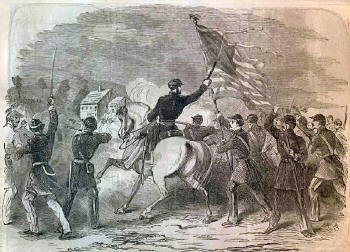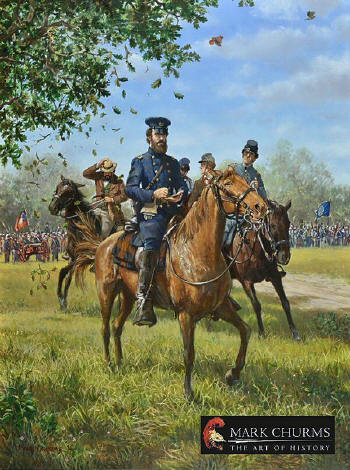|
(2015) Enlarge
In Spring, 1861, Jackson held department command in the extreme north of
the state, separated from neighboring Maryland by the Potomac River and
stretching from Harpers Ferry westward north of Martinsburg. He was
superseded in his post by another Virginian, Brig. Gen. Joseph E.
Johnston, retaining command of his brigade of fewer than 4,000 men, which
took post just north of Martinsburg at Camp Stephens. This part of
Maryland had already been occupied by Northern troops from Pennsylvania
and states from the Old Northwest led by Pennsylvania militia General
Robert Patterson, like Federal Commanding General Winfield Scott, a
veteran of both the War of 1812 and Mexico. Patterson had retired from the
Regular Army but returned to the colors when war broke out. |
|
(2015) Enlarge
Patterson's orders were to use his 18,000 men to prevent the 11,000 now
led by Johnston from reinforcing Brig. Gen. Pierre G. T. Beauregard at
Manassas Junction near the Federal Capital. In the early morning hours of
July 2, 1861, his men began to cross the Potomac at the ford near the
mouth of the creek above, only yards from the waterfall. Unopposed, they
soon approached the nearby village of Falling Waters. Meanwhile, Jackson
learned of the crossing and set out with only the 5th Virginia and the
four-gun Rockbridge Artillery of his brigade; the 2nd and 4th Virginia
were left with orders to stand ready if called, and the 27th Virginia was
set to loading baggage into wagons in case it became necessary to retreat.
Jackson also took along some of the 1st Virginia Cavalry under their Lt.
Col. James E. B. Stuart to cover his flank as he advanced. |
|
(2015) Enlarge
Detail Leaving
three of Capt. William N. Pendleton's guns a short distance in the rear,
Jackson continued on with 350 men of the 5th and a single cannon. Two
companies were placed in and around the house and barn of local Unionist
William Porterfield, above, which stands on the Valley Turnpike, now U.S.
11 a few miles south of the Potomac crossing site. Patterson's leading
brigade, under his son-in-law J. J. Abercrombie, advanced cautiously,
grossly overestimating Jackson's force at ten times its actual number.
Jackson was under orders from the equally cautious Joe Johnston not to
bring on a general engagement, so withdrew after about an hour's fighting,
most of it at long range. Jackson had followed his instructions to
determine the size of the enemy force, falling back on his main body at
Camp Stephens which he then abandoned for a position south of Martinsburg
where he was joined by Johnston and the rest of his army. Casualty figures
vary from a couple of dozen to as many as a hundred or so for each side,
but between those numbers is likely. |
|
(2015) Enlarge
Meanwhile, Stuart, while covering Jackson's left flank, had managed to
capture a fifty-man company of Indiana infantry by himself; his blue
Regular Army uniform confused them until it was too late! To his
everlasting calumny, Patterson did not pursue the retreating Jackson past
Camp Stephens, which he reached the same afternoon. He seems to have felt
he had done all he could, and that it was enough to pin the Confederates
in place. Johnston waited until July 8 for the attack which never came,
then withdrew nearer Winchester; a little more than a week later, behind a
screen of Stuart's cavalry, Johnston left the Valley to succor Beauregard
at Manassas where together they won the first real battle of the Civil
War. |
|
(2015) Enlarge
This marker beside U.S. 11 commemorates one of the legends that sprung up
around the future "Stonewall" Jackson. According to Corporal William Brown
of the Rockbridge Artillery.
Seating himself on a large, loose, round stone on the north side of the
road, he commenced to write... A shot from a Federal battery struck
centrally, ten feet from the ground, a large white oak that stood in the
fence corner close to Jackson and knocked a mass of bark, splinters and
trash all over him and the paper on which he was writing. He brushed away
the trash with the back of his hand, finished the dispatch without a sign
that he knew anything unusual was going on, folded it, handed it to the
courier and dismissed him courteously: "Carry this to General Johnston
with my compliments, and see that you lose no time on the way." |
|
(2015) Enlarge
Calm Under Fire by Mark Churms depicts an alternate version of this
incident showing Jackson and his staff members mounted; copy of print
available from the
Falling Waters Battlefield Association |

